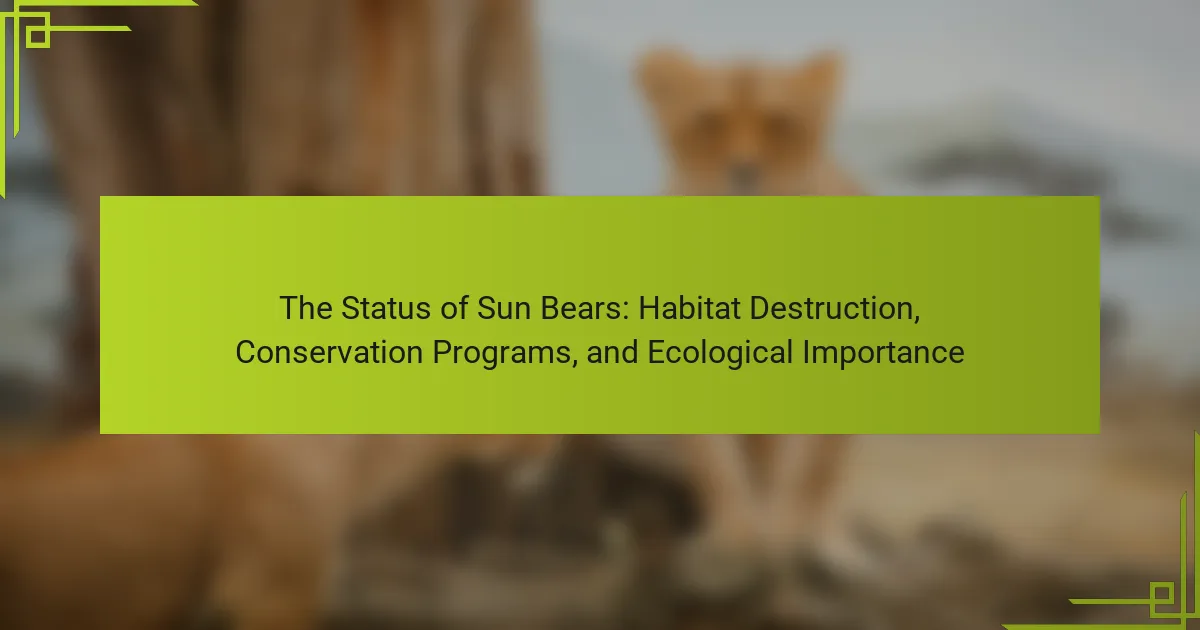Sun bears, the smallest bear species native to Southeast Asia, are vital for their ecosystems as seed dispersers and contributors to soil health. However, their populations are declining due to habitat loss from deforestation, poaching for body parts, and the impacts of climate change. Conservation efforts are underway, focusing on habitat protection, rehabilitation, and community involvement to mitigate these threats. Organizations like the Bornean Sun Bear Conservation Centre play a key role in raising awareness about the ecological importance of sun bears and promoting coexistence between humans and wildlife. The article examines the status of sun bears, detailing the threats they face, the significance of their ecological roles, and the ongoing conservation initiatives aimed at their protection.

What are Sun Bears and their significance in the ecosystem?
Sun bears are the smallest bear species, native to Southeast Asia. They play a crucial role in their ecosystem as seed dispersers. By consuming fruits, they help in the growth of various tree species. Their foraging behavior also contributes to soil aeration. This process enhances the health of the forest floor. Sun bears are also predators of insects and small animals. This helps control those populations and maintains ecological balance. Their decline due to habitat loss threatens these ecological functions.
How do Sun Bears contribute to biodiversity?
Sun bears contribute to biodiversity primarily through their role as seed dispersers. They consume a variety of fruits and berries, which aids in the propagation of plant species. This behavior enhances forest regeneration and maintains ecosystem health. Additionally, their foraging activities help control insect populations. By digging for insects and larvae, sun bears influence soil aeration and nutrient cycling. Their presence in the ecosystem supports a diverse range of flora and fauna. Research indicates that areas with healthy sun bear populations exhibit greater plant diversity. This diversity is crucial for resilient ecosystems and overall biodiversity.
What roles do Sun Bears play in seed dispersal?
Sun bears play a crucial role in seed dispersal within their ecosystems. They consume a variety of fruits, which contain seeds. As sun bears digest these fruits, they excrete the seeds in different locations. This process helps in the germination and growth of new plants. Research indicates that sun bears can disperse seeds over significant distances. Their foraging habits contribute to forest regeneration. This ecological function supports biodiversity in their habitats. Studies have shown that areas with healthy sun bear populations have greater plant diversity.
How do Sun Bears impact their habitat’s food chain?
Sun bears impact their habitat’s food chain primarily as omnivores. They consume a variety of foods, including fruits, insects, and small animals. This foraging behavior helps control insect populations and aids in seed dispersal. By eating fruits, they facilitate the growth of various plant species. Additionally, their predation on insects supports the balance of the ecosystem. Sun bears also serve as prey for larger predators, contributing to the food web. Their activities influence the distribution of flora and fauna in their habitats. Research indicates that sun bears play a crucial role in maintaining the health of tropical forests. Their presence is vital for ecological stability.
What are the unique characteristics of Sun Bears?
Sun bears have several unique characteristics. They are the smallest bear species, typically weighing between 60 to 150 pounds. Their fur is short and sleek, often appearing black with a distinctive orange or cream-colored chest patch. This patch is unique to each individual, much like a fingerprint. Sun bears possess long tongues, measuring up to 9 inches, which they use to extract honey and insects from trees. Their strong claws are adapted for climbing, allowing them to navigate their forest habitat effectively. Additionally, sun bears are primarily nocturnal, being most active during the night. They have a specialized diet that includes fruits, insects, and honey, showcasing their role in seed dispersal within their ecosystem. These characteristics highlight their adaptability to tropical forest environments.
What physical attributes distinguish Sun Bears from other bear species?
Sun Bears are distinguished by their small size and unique physical features. They are the smallest bear species, typically weighing between 60 to 150 pounds. Their fur is short and sleek, primarily black with a distinctive orange to cream-colored chest patch. This patch is often shaped like a crescent or a V, setting them apart visually. Sun Bears also have long tongues, which can reach up to 10 inches, aiding them in extracting insects and honey from trees. Their limbs are relatively long and powerful, adapted for climbing. Additionally, they possess large, curved claws that assist in digging and climbing. These attributes, combined with their unique coloration, make Sun Bears easily identifiable among other bear species.
What behavioral traits are unique to Sun Bears?
Sun Bears exhibit several unique behavioral traits. They are known for their exceptional climbing abilities, often ascending trees to forage for food. Sun Bears primarily feed on insects, honey, and fruits, showcasing their adaptability in diverse habitats. They have a distinctive method of foraging, using their long tongues to extract honey from beehives. Additionally, Sun Bears are primarily nocturnal, being more active during the night. They communicate through vocalizations and scent marking, establishing territory and social interactions. Their solitary nature sets them apart from other bear species, as they prefer to live alone rather than in groups. These behaviors reflect their ecological role as opportunistic feeders in their rainforest habitats.

What are the primary threats to Sun Bears?
The primary threats to Sun Bears include habitat loss, poaching, and climate change. Habitat loss occurs due to deforestation and agricultural expansion. This reduces their natural environment and food sources. Poaching poses a significant risk as Sun Bears are hunted for their bile and body parts. Climate change affects their habitat and food availability. Rising temperatures and altered rainfall patterns disrupt their ecosystem. These threats have led to a decline in Sun Bear populations. Conservation efforts are needed to address these challenges and protect the species.
How does habitat destruction affect Sun Bear populations?
Habitat destruction significantly impacts Sun Bear populations by reducing their natural living space. This leads to decreased food availability, as Sun Bears rely on specific habitats for foraging. Fragmented habitats isolate populations, hindering their ability to mate and reproduce. As a result, genetic diversity diminishes, making populations more vulnerable to diseases. According to the IUCN, Sun Bears are classified as vulnerable, with habitat loss being a primary threat. Deforestation in Southeast Asia has led to a 30% decline in their population over the last few decades. The destruction of their habitat also increases human-wildlife conflict as bears search for food in agricultural areas. Overall, habitat destruction poses a critical threat to the survival of Sun Bears.
What human activities contribute to habitat loss for Sun Bears?
Deforestation is a primary human activity contributing to habitat loss for Sun Bears. Logging operations clear vast areas of forest, reducing their natural habitat. Agricultural expansion further exacerbates this issue by converting forest land into plantations. Urban development encroaches on Sun Bear habitats, fragmenting their living spaces. Poaching and illegal wildlife trade also threaten their populations. These activities lead to significant declines in their habitat quality and availability. Studies show that Sun Bears rely on dense forest cover for food and shelter. The loss of their habitat directly impacts their survival and reproduction rates.
How does deforestation impact Sun Bear survival?
Deforestation significantly threatens Sun Bear survival. The loss of forest habitat reduces their food sources, such as fruits and insects. Sun Bears rely on dense forests for shelter and breeding. Without adequate habitat, their populations decline. Studies indicate that habitat fragmentation leads to increased mortality rates. Additionally, deforestation exposes Sun Bears to poaching and human-wildlife conflict. As forest areas shrink, their ability to find mates diminishes. This results in decreased genetic diversity and increased vulnerability. Overall, deforestation poses a critical risk to the survival of Sun Bears.
What role does climate change play in the decline of Sun Bears?
Climate change significantly contributes to the decline of Sun Bears. Rising temperatures and changing rainfall patterns disrupt their natural habitats. These bears rely on specific forest ecosystems for food and shelter. As climate change alters these ecosystems, food sources like fruits and insects become scarce. Deforestation, exacerbated by climate change, further reduces their habitat. Increased human activity, driven by climate-related factors, leads to habitat fragmentation. This fragmentation isolates bear populations, making it difficult for them to find mates. Overall, climate change poses a direct threat to the survival of Sun Bears by impacting their habitat and food availability.
How are changing weather patterns affecting Sun Bear habitats?
Changing weather patterns are negatively impacting Sun Bear habitats. Increased temperatures and altered rainfall patterns affect the availability of food sources. Sun Bears rely on fruits, insects, and honey, which are sensitive to climate changes. Deforestation further exacerbates habitat loss, limiting their range. Studies show that rising temperatures can lead to reduced fruiting seasons in tropical forests. This directly affects the nutritional intake of Sun Bears. Additionally, erratic weather can cause flooding or droughts, disrupting their habitats. These changes threaten the overall survival of Sun Bear populations.
What are the long-term implications of climate change for Sun Bear populations?
Long-term implications of climate change for Sun Bear populations include habitat loss and altered food availability. Climate change leads to increased temperatures and altered rainfall patterns. These changes can result in the degradation of tropical forests, which are critical for Sun Bears. As forests diminish, Sun Bears face reduced access to their food sources, such as fruits and insects. A study by the World Wildlife Fund indicates that habitat loss can lead to population declines. Additionally, climate change may increase the frequency of extreme weather events, further threatening their survival. Overall, these factors contribute to a challenging future for Sun Bear populations.

What conservation programs are in place for Sun Bears?
Conservation programs for Sun Bears include habitat protection, rehabilitation efforts, and community engagement initiatives. Organizations like the Bornean Sun Bear Conservation Centre focus on rescuing and rehabilitating Sun Bears. They provide education on the importance of Sun Bears in the ecosystem. Habitat preservation is crucial, as deforestation threatens their living space. Additionally, local communities are involved in conservation efforts through awareness campaigns. These programs aim to reduce human-wildlife conflict and promote coexistence. Research indicates that protecting Sun Bear habitats can enhance biodiversity and ecosystem health.
How effective are current conservation efforts for Sun Bears?
Current conservation efforts for Sun Bears are moderately effective but face significant challenges. Habitat loss due to deforestation continues to threaten their populations. Conservation programs focus on habitat protection and rehabilitation. Some initiatives include community engagement to reduce human-wildlife conflict. Research indicates that protected areas have shown population stability in some regions. However, poaching remains a critical issue affecting their survival. Increased funding and awareness are needed for long-term success. Collaboration between local communities and conservation organizations is essential for sustainable outcomes.
What organizations are actively working to protect Sun Bears?
Organizations actively working to protect Sun Bears include the Bornean Sun Bear Conservation Centre, the World Wildlife Fund (WWF), and the International Animal Rescue. The Bornean Sun Bear Conservation Centre focuses on rehabilitation and education. The WWF engages in habitat preservation and anti-poaching efforts. International Animal Rescue works on rescue and rehabilitation of injured bears. These organizations contribute significantly to the conservation of Sun Bears through various initiatives. Their efforts aim to address threats such as habitat destruction and illegal hunting.
What strategies are being implemented to preserve Sun Bear habitats?
Strategies to preserve Sun Bear habitats include establishing protected areas and enforcing anti-logging laws. Conservation organizations work to create national parks that safeguard vital habitats. Reforestation efforts are also underway to restore degraded areas. Community engagement programs educate locals about the importance of Sun Bears. Sustainable land-use practices are promoted to minimize habitat destruction. Research initiatives monitor Sun Bear populations and habitat health. Collaboration with local governments helps implement effective conservation policies. These strategies aim to ensure the long-term survival of Sun Bears and their ecosystems.
What can individuals do to support Sun Bear conservation?
Individuals can support Sun Bear conservation by donating to wildlife organizations focused on their protection. Donations help fund habitat preservation and rescue efforts. Participating in local conservation programs raises awareness about Sun Bears. Volunteering for wildlife rehabilitation centers provides direct assistance to injured bears. Educating others about the threats Sun Bears face fosters community involvement. Avoiding products linked to deforestation helps protect their natural habitats. Supporting sustainable tourism initiatives promotes conservation-friendly practices. Lastly, advocating for stronger wildlife protection laws influences policy changes that benefit Sun Bears.
How can local communities participate in conservation initiatives?
Local communities can participate in conservation initiatives by engaging in habitat restoration projects. These projects often involve replanting native trees and removing invasive species. Community members can also participate in wildlife monitoring programs. This includes reporting sightings and tracking animal movements. Educational workshops can be organized to raise awareness about local conservation efforts. Collaborating with conservation organizations helps to secure funding and resources. Volunteering for clean-up drives in natural habitats is another effective way to contribute. Finally, local communities can advocate for policies that protect their environment. These actions collectively enhance conservation outcomes and promote sustainability.
What actions can global citizens take to aid Sun Bear protection?
Global citizens can aid Sun Bear protection by supporting conservation organizations. These organizations work on habitat preservation and anti-poaching initiatives. Donations help fund research and rescue efforts for Sun Bears. Raising awareness about Sun Bear conservation is crucial. Citizens can share information through social media and community events. Participating in local conservation programs fosters direct engagement. Responsible tourism practices help minimize human impact on Sun Bear habitats. Lastly, advocating for policy changes can lead to stronger protections for Sun Bears.
What is the future outlook for Sun Bears in the wild?
The future outlook for Sun Bears in the wild is concerning. Habitat destruction significantly impacts their populations. Deforestation for agriculture and urban development reduces their natural habitats. Poaching poses another major threat to Sun Bears. Conservation programs are essential for their survival. Protected areas and wildlife corridors can help sustain their populations. Research indicates that with proper management, Sun Bear populations could stabilize. However, ongoing threats require continuous monitoring and intervention.
What trends are emerging in Sun Bear population recovery?
Emerging trends in Sun Bear population recovery include increased awareness and conservation efforts. Habitat protection initiatives are expanding in Southeast Asia, where Sun Bears reside. Anti-poaching laws are being enforced more strictly, reducing illegal hunting. Community engagement programs are educating locals about the ecological importance of Sun Bears. Rehabilitation centers are successfully releasing captive bears back into the wild. Research indicates a slow but steady increase in population numbers in certain protected areas. Collaboration between NGOs and governments is fostering sustainable practices. These trends suggest a positive trajectory for Sun Bear recovery efforts.
How can continued conservation efforts influence the future of Sun Bears?
Continued conservation efforts can significantly improve the future of Sun Bears. These initiatives help protect their natural habitats from deforestation and human encroachment. By establishing protected areas, conservation programs ensure that Sun Bears have safe environments to thrive. Education and awareness campaigns can reduce human-wildlife conflict, fostering coexistence. Research indicates that habitat preservation is crucial for the survival of Sun Bears, as their populations are declining due to habitat loss. Additionally, rehabilitation programs for orphaned or injured bears can enhance population numbers. Effective conservation strategies can lead to increased genetic diversity, improving the species’ resilience. Overall, sustained efforts can reverse the decline and secure a stable future for Sun Bears.
Sun bears, the smallest bear species native to Southeast Asia, play a vital role in their ecosystem as seed dispersers and insect predators, contributing to biodiversity and ecological balance. This article examines the threats they face, including habitat destruction due to deforestation and poaching, which significantly impact their populations. It also highlights ongoing conservation programs aimed at protecting their habitats and raising awareness about their ecological importance. The discussion includes the unique characteristics and behaviors of sun bears, the implications of climate change on their survival, and the collaborative efforts needed to ensure their future in the wild.
